Research
In this page, we list some of our ongoing projects and research interests. Please feel free to reach out to us if any of these topics interest you and if you would like to discuss potential collaborations. Interested students and postdocs looking for a position can reach out to us at ankur.gupta@colorado.edu.
Overarching Research Theme
LIFE is passionate about building technologies for a sustainable future. Broadly speaking, we use computational tools to design and engineer technologies such as batteries, supercapacitors, electrochemically mediated carbon capture and lab-on-a-chip devices. We study these systems using a variety of computational tools, where we blend more traditional applied mathematics with modern computing capabilities to solve challenging problems.
Students and researchers in our group can expect to develop skill sets in advanced transport phenomena, microhydrodynamics, energy storage, electrokinetics, electrochemistry, numerical methods, matched asymptotics, soft material synthesis, rheology, scaling analysis, etc.
We have provided more details of projects below. We are a highly collaborative and dynamic group and are always looking to work on exciting problems. Please feel free to connect if you are interested in discussing any particular project in more detail.
Electrokinetic Phenomena
Electrokinetic phenomena relate traditional transport phenomena to the out-of-equilibrium processes where ions (such as Na+ and Ca2+ ions) respond to an external stimulus such as an electric field. A critical feature of all electrokinetic phenomena is the presence of an electrical double layer (EDL), i.e., the thin region near a charged surface that preferentially contains either positively charged ions (cations) or negatively charged ions (anions). For instance, if a positively charged surface comes into contact with an electrolyte solution, say sodium chloride, chloride ions will get attracted toward the surface to form an EDL. Though the typical thickness of EDL is only about 1-10 nm, it influences the physical processes at much larger length scales ranging from 1 m to 1 mm. Therefore, electrokinetic phenomena have been exploited for applications in supercapacitive energy storage, gel electrophoresis (a technology to separate DNA molecules based on size), lab-on-a-chip devices, and desalination, among others.
There are several approaches to modeling EDL phenomena. Atomic-scale models, such as molecular dynamics and Monte Carlo simulations, are capable of providing significant information about the arrangement of ions and the properties of EDL. However, these models are computationally intensive and are thus less suited for out-of-equilibrium processes that occur at longer time scales. In contrast, Poisson-Boltzmann models are computationally friendly and are suitable for out-of-equilibrium processes but are unable to capture details such as ionic layering. In our research, we seek to incorporate these subtle effects by developing theoretical and computational frameworks, while also investigating different applications. In particular, we are interested in the following electrokinetic phenomena:
Charging and Discharging of Supercapacitors
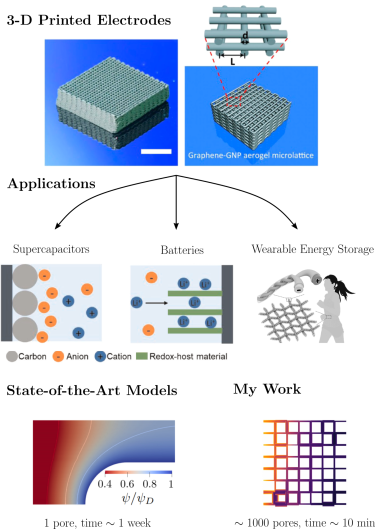
Project lead: Filipe Henrique
Collaborator: Pawel J. Zuk, Polish Academy of Sciences
Supercapacitors are energy storage devices whose energy is physically stored in the form of electrical double layers, unlike batteries where the energy is stored chemically through oxidation and reduction reactions. Supercapacitors have significantly higher power density than batteries, thus they are employed in applications where fast energy delivery is required, such as energy grid storage, emergency exits in airplanes, and initial acceleration in electric cars, etc.
Though the research of materials for supercapacitors has progressed significantly, the transport mechanism of ions remains poorly understood even today. Typically, researchers assume an effective circuit to model the charging and discharging mechanism of these devices. However, they have a range of length scales such as pore sizes, thickness of electrodes, distance between electrodes, etc. Moreover, the pore sizes of these systems can be often comparable to the ion sizes. Therefore, there is an important need to model ion transport from first principles. To this end, we envision a model that is able to incorporate the aforementioned effects systematically.
Relevant publications: Henrique, Zuk, and Gupta, Electrochimica Acta 2022, Henrique, Zuk, and Gupta, Soft Matter 2022, Gupta et al. Physical Review Letter 2020
Electric-Double-Layer Structure in Multicomponent Electrolytes
Project lead: Filipe Henrique
Collaborator: Lawrence Livermore National Lab
Despite its usefulness, Poisson-Boltzmann (PB) theory misses critical information of the electric-double-layer structure of multicomponent electrolytes for high surface charges. In such systems, volume exclusion effects may play a decisive role in the relative concentration of counterions near a charged surface. In this setting, the population of ions may be dominated by those with lower radii, even if they have lower valences, leading to ion segregation, in contrast to PB theory predictions. Some work in the literature has devised a modified PB theory framework that incorporates finite-volume effects via a Boublik–Mansoori–Carnahan–Starling–Leland correction of the chemical potential. In this project, we seek to obtain physical insights from the model via an asymptotic expansion for a small size polydispersity in three-ion mixtures.
Charging Dynamics of Multicomponent Electrolytes with Reactions and EDLs
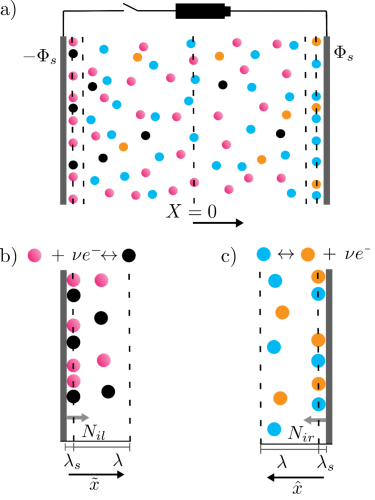
Project Lead: Nathan Jarvey
Collaboration: Holewinski Group, CU Boulder
Energy storage devices commonly use two distinct mechanisms; a physical mechanism derived from physical attraction of ions into an EDL and a chemical mechanism derived from electrochemical reactions at a surface. In hybrid capacitor, desalination, and battery applications, both of these mechanisms play a pivotal role in driving ion transport. However, the effects of coupled EDLs and electrochemical reactions on cell dynamics remain poorly understood. Additionally, it is difficult to model multiple sets of electrochemical reactions, supporting electrolytes, and asymmetries in ion valence, diffusivity, and ion size- all of which have significant impacts on real systems. As such, our goal with this project is to develop a general model for electrochemical cells which can account for all these effects simultaneously.
Relevant publications: Jarvey, Henrique, and Gupta, Journal of the Electrochemical Society 2022
Reaction-Induced Asymmetric Rectified Electric Fields
Project Lead: Nathan Jarvey
Collaboration: Feel free to reach out if interested in collaborating
When applied to electrolytes where ions have asymmetric diffusivities, an AC electric field is known to leave a nonzero time-averaged electric field, otherwise known as an asymmetric rectified electric field (AREF). We recently discovered that electrochemical reactions can be used to produce AREFs through a different, but related, mechanism, and can also be used to enhance AREFs caused by asymmetric diffusivities. The goal of this project is to outline the mechanism through which reactions lead to AREFs and propose a general model to model AREFs in multicomponent electrolytes which can have both reactions and asymmetric diffusivities.
Self-Propulsion of Microparticles and Droplets in Phoretic Systems
Synthetic microswimmers have a wide range of applications such as non-invasive medicine, targeted drug delivery, and lab-on-chip devices. Over the last two decades, theoretical research has focused on predicting the motion of microswimmers, which are generally assumed to be spheroidal or cylindrical. The motion of these microswimmers is driven due to interactions with an external field or by the generation of a local field due to asymmetries in activity on the particle surface. Recently, there has been an increasing interest in understanding the impact of the geometric asymmetry of particles, and if the geometric design of the particle can provide an additional degree of freedom to tune the particle trajectory.
Induced-Charge Electrophoresis
Project lead: Arkava Ganguly
Collaboration: Shields Lab, CU Boulder
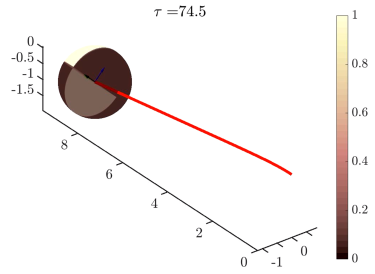
The induced charge electrophoretic motion of particles in an unbounded fluid and near walls has been well-studied in literature. However, the dynamics of such systems for more complex agglomerates, clusters dimer and trimer configuration, and the effect of patch shape have not been well studied in this system. We capture the hydrodynamic interactions via a mobility formulation. To couple these hydrodynamic interactions with the electrostatic interactions, we resolve the electrostatic slip induced by the formation of an EDL at the surface of the particle in the presence of an electric field.
Active Diffusiophoresis
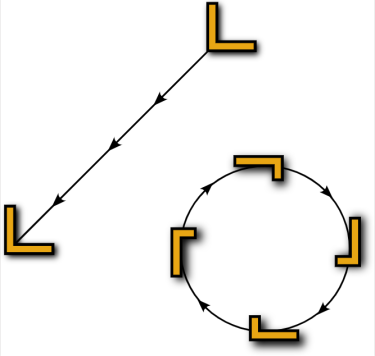
Effects of particle shape
Project lead: Arkava Ganguly
Collaboration: Feel free to reach out if interested in collaborating
We investigate the self-diffusiophoretic motion of a two-dimensional bent rod by employing slender-body theory. Our framework to predict the motion of the particle consists of two steps. First, we first calculate the diffusiophoretic slip velocity by solving the species conservation equation. Second, we employ the reciprocal theorem to obtain the particle translational and angular velocity. We analyze the particle motion for two scenarios: (1) both arms of the bent rod are active, and (2) one arm is active and the other is passive. In each case, we study the impact of geometry, i.e., the relative lengths and the angle between the two arms. Our study reveals that the particle typically follows a circular trajectory with a constant radius and a turning frequency. We quantify the impact of geometry on the speed, turn frequency, and radius of the particle trajectory. We find that particle geometry in the second scenario, i.e., when only one arm is active, provides a higher degree of control over particle motion.
Link to article: https://journals.aps.org/prfluids/abstract/10.1103/PhysRevFluids.8.014103
Effects of reactive patch shape
Project lead: Arkava Ganguly
Undergraduate: Zoe Cruse
The goal of this project is to predict apriori the trajectories of spherical particles with arbitrarily shaped catalytic patches moving via self-diffusiophoresis. Although trajectory dependence on particle shape has been widely studied, there has been no theoretical work on how motion profiles of spherical particles with arbitrary catalytic patches can be predicted. Our study involves a semi-analytic approach to capture the rich particle dynamics for very weirdly shaped patches. We also validate our methods with more rigorous analytical solutions for standard shapes such as uniformly active particles and Janus particles.
Passive Diffusiophoresis
Studies on passive d
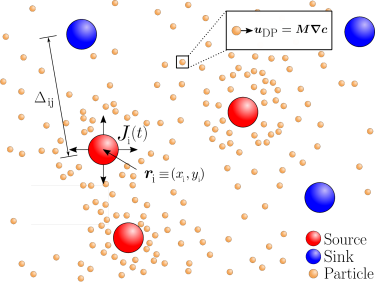
iffusiophoresis, i.e. particles driven by a global solute concentration gradient, have typically focused on the response of particles in one-dimensional systems. However, there have been experimental and theoretical works showing that interesting behavior can be observed in two- and three-dimensional systems. We are interested in building computational models to learn how the motion of diffusiophoretic particles can be controlled in two and three-dimensional systems.
Colloidal banding in two-dimensional systems
Project lead: Ritu Raj
The goal of this project is to study how two-dimensional solute gradients can be used to band, or locally enhance, the number of diffusiophoretic particles in tunable ways. In a recent work we have explored how point sources and sinks of solute can be used to band particles in two dimensions. We show that an interplay between diffusion and source/sink flux decay timescales governs the banding of particles. We have been expanding this work to include more effects such as reactions and finite sizes.
Link to article: https://pubs.rsc.org/en/content/articlehtml/2023/sm/d2sm01549h
Active Droplets
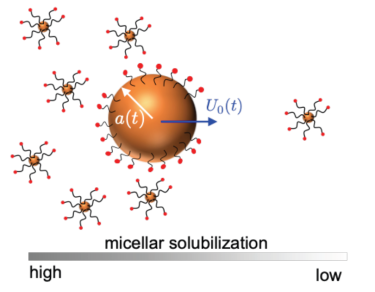
Self-propulsion of solubilizing droplets
Project lead: Arkava Ganguly
In this project, we investigate the physical system of active droplets, which propel themselves due to micellar mobilization at finite Peclet and capillary numbers, thereby closely mimicking the conditions of a surfactant flood. There are two factors that make the analysis of active droplets challenging. First, micellar solubilization is a time-dependent process, and thus the droplet size and propulsion speed change with time. Second, unlike rigid particles, droplet can change its shape due to self-propulsion. To tackle these challenges, we propose a rigorous non-equilibrium analysis that predicts (i) the time-dependence of droplet size and propulsion speed through by solving coupled fluid flow and species transport equations, (ii) in-situ change in droplet shape by exploiting perturbation expansion in small capillary numbers, and (iii) interaction between two active droplets by utilizing Lorentz reciprocal theorem. In summary, our analysis will provide a mechanistic understanding of active droplet propulsion and advance our understanding of non-equilibrium transport due to micellar solubilization in a surfactant flood.
Propulsion of Microparticles Driven by External Fields
The motion of microparticles driven by external fields has shown promise in recent years due to applications to microrobotics. These small robots, powered by fields such as acoustic and magnetic fields, are poised to become next-generation biomedical and environmental remediation technologies. We are interested in studying how the motion of these particles is dependent on the system in which they are actuated.
Magnetic helical particles in biological environments
Project lead: Ritu Raj
Collaboration: Shields Group, CU Boulder
The non-reciprocal requirement for locomotion at low Reynolds numbers has a number of consequences, specifically at the scale at which many biological mechanisms occur. This means that any attempts to build machines that operate at a microbiological length scale must be designed to move non-reciprocally. One means for doing this is to take inspiration from organisms that do locomote at microbiological length scales, such as bacterial cilia and flagella. These organisms utilize a helical shape that allows for locomotion upon rotation. In this way, magnetic helically shaped particles can be made to propel in controllable directions in response to rotating magnetic fields. In this project, we are interested in investigating how biologically relevant environments, such as those with complex fluids and cells, impact the motion of magnetic helical particles.
Tuning acoustic microrobot motion with geometric design alterations
Project lead: Ritu Raj
Collaboration: Shields Group, CU Boulder
One alternative mechanism for actuating microrobots is with acoustic fields. Certain micron-scale objects, such as bubbles and thin structures, can harmonically respond to an acoustic field. If designed properly, this response can generate a time-averaged flow known as acoustic streaming. In this project we are using experimental and computational tools to understand how particle design can be used to induce specific motions.

